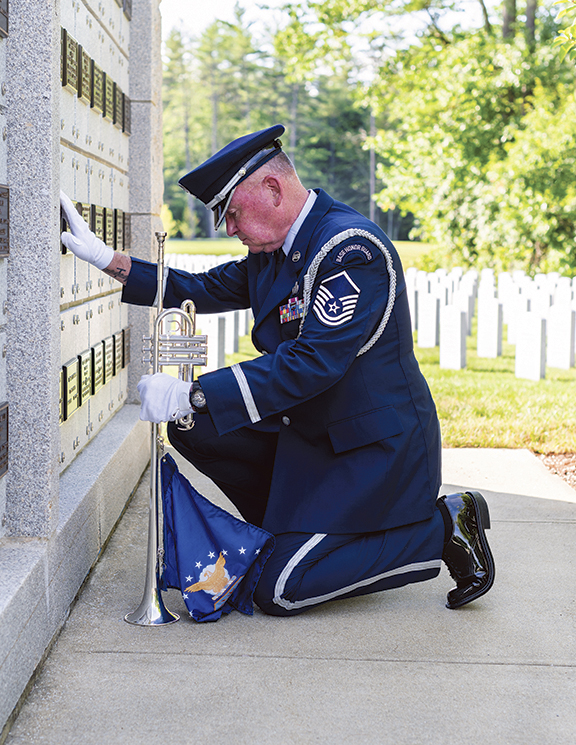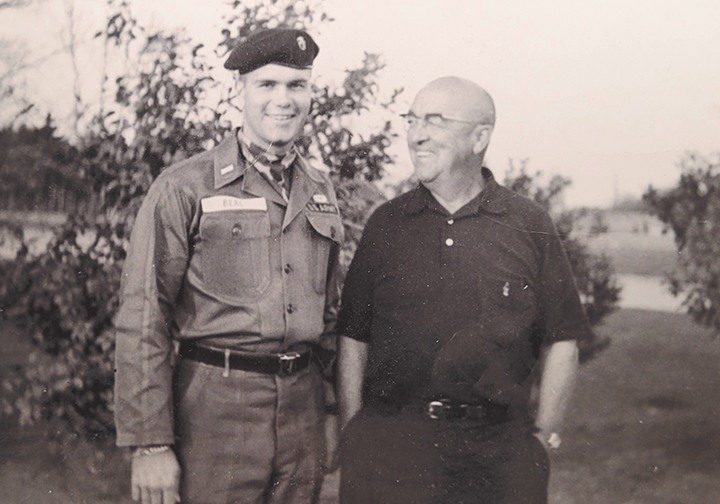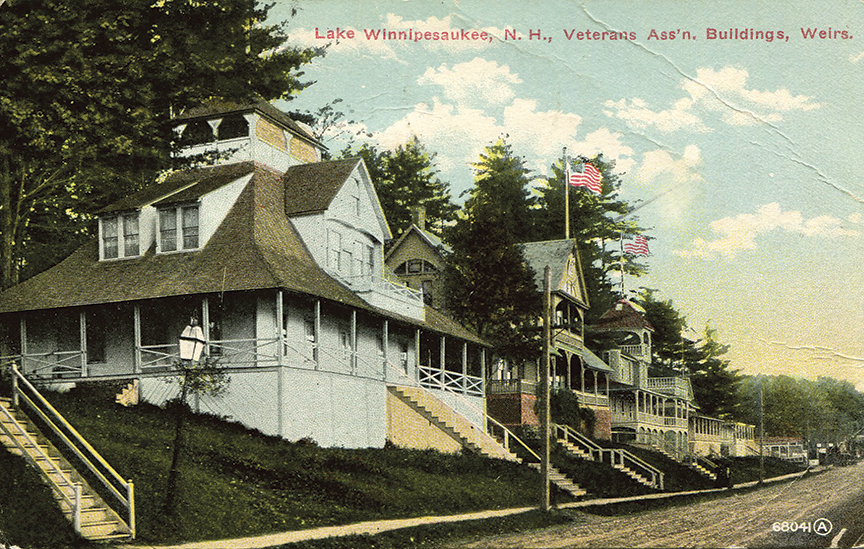A Living Place Honoring Those Who Served

PHOTO: Retired U.S. Air Force Master Sgt. Lee Hirtle, one of the volunteer buglers who plays taps regularly at the New Hampshire Veterans Cemetery, kneels with his herald trumpet at the tomb of his son, Air Force Staff Sgt. Jason Hirtle, who died in 2014. Courtesy Photo
By Dan Seufert
Weirs Times Correspondent
Each night from Memorial Day through September 11, a lone bugler stands at attention and plays taps to honor and respect the more than 13,000 veterans and family members whose final resting place is the New Hampshire State Veterans Cemetery in Boscawen.
At 7 p.m. on that day, taps will be played a final night to close the yearly “100 Nights of Remembrance,” a summer-long event meant to honor Americans who served the country honorably in any branch of the Armed Forces.
One of the volunteer horn players, Retired U.S. Air Force Master Sgt. Lee Hirtle, plays to honor his son, Air Force Sgt. Jason Hirtle, who is among the veterans buried at the cemetery, which will be celebrating its 25th anniversary next year.
Hirtle’s duty as a bugler is to honor all of his fellow veterans at the cemetery. His responsibility goes far beyond honoring his son, he said.
“The people here swore to defend our country,” said Hirtle. “They certainly deserve a live bugler.”

Though the cemetery was built specifically to honor New Hampshire veterans who have died, the interments are just one part of the cemetery now. Since it opened in 1997, new additions and improvements to the main buildings have made visiting a learning experience. There is a new Learning Center building, and on the extensive Memorial Walk around the outside the buildings, there are numerous brilliantly cut and engraved monuments to honor veterans of particular wars and different eras.
The displays inside and outside are filled with names of veterans and information about the wars in which they fought or the time they served, and there are plans to make even more information available to people about each veteran simply by pointing a device at a grave.
“This cemetery is full of life these days, and it keeps getting better every year,” Hirtle said.
Area school students now come to the cemetery to learn, and there are plans for more student involvement, said Shawn Buck, the cemetery director. Volunteers from area communities help the cemetery’s small staff maintain the property and complete “beautification projects,” Buck said. The operation has truly become a success story, with people from many communities chipping in.
Of course, it’s true that as a cemetery, this is a place of mourning, loss and sadness. And it’s also true that the cemetery buried more veterans in June and July than ever before, in part due to the COVID-19 virus. June saw the largest increase, from 132 interments in 2020 to 152 this year.
“We’ve had our busiest months ever,” Buck said. “But the increase in interments is not necessarily directly caused by the virus. There are a lot of reasons for the higher numbers, some of it is because folks delayed interments due to the pandemic, and some of it is not related to (COVID-19).”

This summer’s additional interments, though sad, didn’t darken the grounds or taint the experience of visiting. Rather, the cemetery has always been a gathering place for families, friends, students, and for living veterans, and it is now a place that teaches people of all ages about our veterans, and celebrates their lives and their service.
Buck, a retired U.S. Army lieutenant colonel, sees it as a very special place.
“Some people think of cemeteries as being creepy, but this cemetery is not,” he said. “This cemetery is tranquil and peaceful. You can feel the history and the honor when you walk through it. It’s an honor to be buried here.”
Richard Marsh, who is not a veteran but is a New Hampshire historian, agrees.
“The people buried there, to me, are superheroes,” said March, whose website, www.images-of-new-hampshire-history.com, is dedicated to the cemetery.


After years of debate on a bill to establish the cemetery, legislation was signed by then-Gov. Steve Merrill in 1994 to create it, with operational funding half from the federal government and half from the state.
“It became a trend around the country in the 1980s to build state veterans cemeteries because national veterans cemeteries were getting filled and more space would be needed to honor World War II veterans,” Buck said.
The state donated the 104 acres of land for the cemetery, and a number of private donations also helped the cause. A ground-breaking ceremony was held in May of 1997. The first burial was in November of that year, the remains of U.S. Navy Chief Warrant Officer Ernest Holm, who served in both World War I and World War II.
In 2001, the New Hampshire Veterans Cemetery Association was established to continue gathering donations and provide general support to the cemetery and its events, and to involve the community and the state in the cemetery’s events.
“The cemetery has a small budget, and we are there to gather support and do everything we can to help the cemetery go from being good to being great, and to help raise public awareness about veterans in general,” said Retired Air Force Maj. General Gretchen Dunkelberger, the president of the cemetery association.
With the association’s help and using donations, the cemetery built the “20 points of N.H. Military History Walkway” exhibit. The association also commissioned and installed stained glass windows in the cemetery’s chapel, and gathered funds to purchase a one-ton utility dump truck. Among its bigger projects, the association gathered funding for the construction and provided oversight for the beautiful New Hampshire Veterans Heritage Learning Center exhibit.
Buck said a lot has been accomplished at the cemetery in 24 years. His predecessors on the job, including Retired Air Force Col. Mike Horn, retired N.H. National Guard Chief Warrant Officer Roger Desjardin, and Lloyd Farham are responsible for many of the improvements and displays, he said.
Among the more recent programs of which Buck is most excited about is the federal Burial Equity for Guards and Reserve Act. Under the current rules, members of the national reserve and guard who were never federally activated or served on active duty were not eligible for burial in the cemetery.
Under a new act, supported by N.H.’s congressional delegation, each state is allowed to determine its own policies on burying members of the Reserves and National Guard in their state veteran’s cemetery.
“This is big for New Hampshire, as we have a pretty large reserve and national guard, who serve important roles and stand ready to be activated. I think it’s important that we as a state can offer burials to all of them,” Buck said.
Another improvement is the cemetery’s “Adopt-A-Garden” program. The cemetery has five full-time staff members and 100 gardens on the property.
“At Arlington National Cemetery they have 35 burials a day, and they have 160 people on their staff just to dig the graves. We average four burials a day and I have a staff of five,” Buck said.
Volunteers, who come from all over the state, pick one or two gardens to take care of during the year. The gardens are doing well with the program, and many of the volunteers have green thumbs, he said.
“I tell them it’s their canvas they can paint what they want, within bounds,” he said.

The cemetery also localized “Wreaths Across America,” which is now “Wreaths for Boscawen,” an event now run without affiliation to the national program. The Blue Star Mothers of New Hampshire – a group of mothers, fathers, siblings, and friends of those serving or who have served their country – volunteered to raise funds, purchase the wreaths locally and coordinate the event. It takes place annually on the first Saturday in December.
New Hampshire Blue Star Mothers raise the money each year to buy 3,500 wreaths to lay at gravestones just before Christmas, Hannukah and the winter holidays. There are more than 6,000 gravestones at the cemetery grounds, and the hundreds of volunteers who come for the event are asked to lay a wreath by every other stone.
They are told to read the name on the stone where they lay a wreath, and then read the names on the grave stones on either side of it. “That way everyone’s name is remembered, and honored,” Buck said.
Among the more somber events that Buck is proud of is the “Standing With Fallen Comrades” program that began in 2019.
Sometimes the cemetery receives a request to bury a veteran or family member with no known next-of-kin or family. The burial service, with military honors if appropriate, is conducted with at least one cemetery staff member in attendance. If given enough notice, the cemetery will reach out to various groups to encourage attendance, and to the volunteer buglers to play taps.
“We get veterans dropped off who have no family, but we will always do honors for them,” he said. “We’ll send out an email to supporters and tell them we’re having a service for this service member, at what time and what day, and we will always get some attendees to help us honor the person. In effect, we become that person’s family.”
“One time we had 85 people come to honor a person with no family,” he said. “So, the effect is, people like this are never alone, somebody will be out there observing the honors and honoring that veteran. I’m really proud of that,” said Buck.
The future looks bright for the cemetery. Of its 104 acres, 58 acres usable “and we have used 19,” Buck said. “The way I see it we’re good for property until at least 2100.”
And the 25th Anniversary celebration, to be held next September, is in the planning stages. “We’re going to invite as many people as possible who helped at the beginning of this place,” including current and past state and federal lawmakers and veterans of all ranks and services, Buck said.
In the meantime, new ideas are hatching at the cemetery. Staff and association members have been teaching students about New Hampshire’s more than 300 years of military service to the country, and they are also giving the teachers ideas for new projects.
Buck envisions students doing research on veterans and family members, and their service and background. The students would then design and build technology that allows visitors to point a smart device at a gravesite to get a history of the person interred there, including their obituary, military service information, and home town.
“The possibilities are endless,” Buck said, adding that area students are often brought to the cemetery to learn, and sometimes use the cemetery’s computer resources for research projects on a local veteran. “There’s so much opportunity to learn here.”
Among the coming events is a 19-mile walk to raise money for veterans adjusting to normal life once they return. On Sept. 25, Marsh and his daughter will leave the veterans cemetery on foot; they will walk to the Veterans Cemetery to the New Hampshire Veterans Home in Tilton. The walk is part of “Run to Home Base,” a Boston Red Sox effort to raise money to help those afflicted with Post-Traumatic Stress Disorder.
Marsh said they very much need donations, which can be made at www.runtohomebase.org/support/#StateHousetoVeteransHome21.
Marsh, like the many others who visit the cemetery regularly, said he’s proud and honored to give back to the people who helped protect America when called to service. He doesn’t feel like he’s going to a graveyard, he said, because the cemetery is so much more than a burial place for veterans.
“It’s really a living place, and it’s so beautiful,” he said. “I go there any chance I get.”



